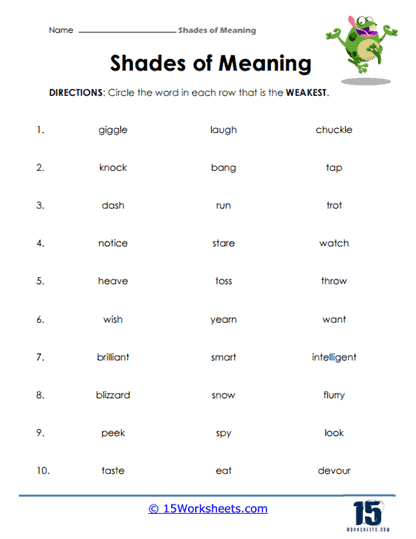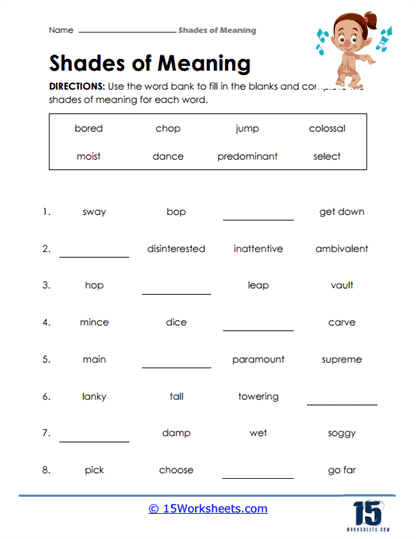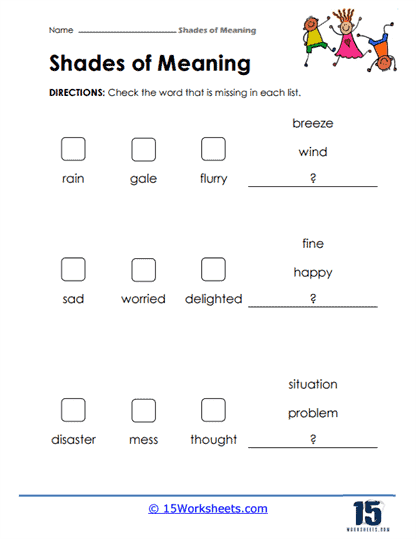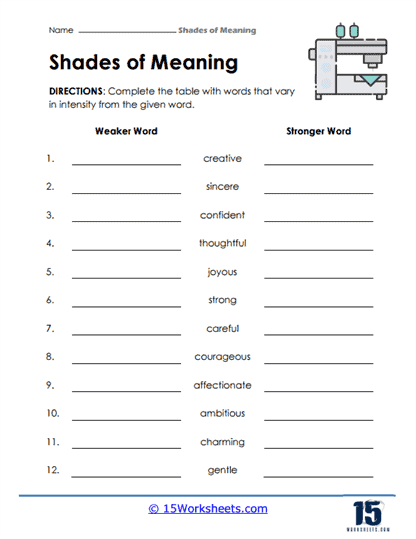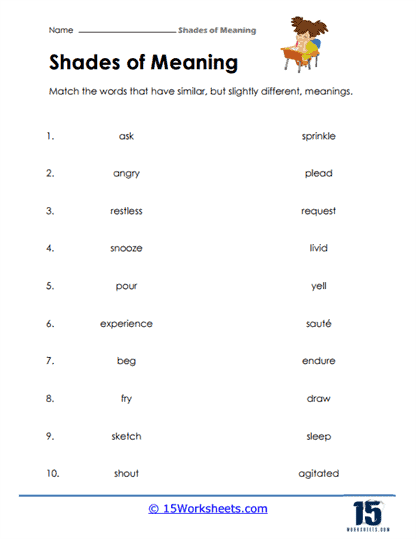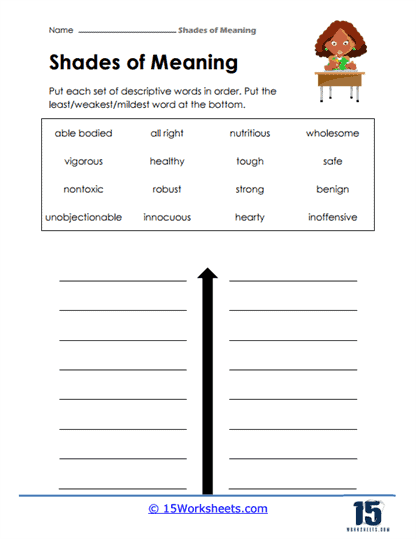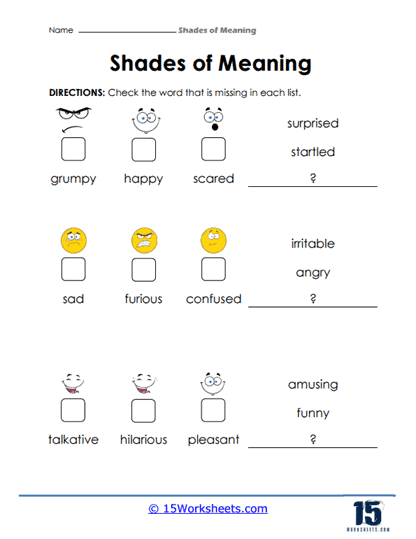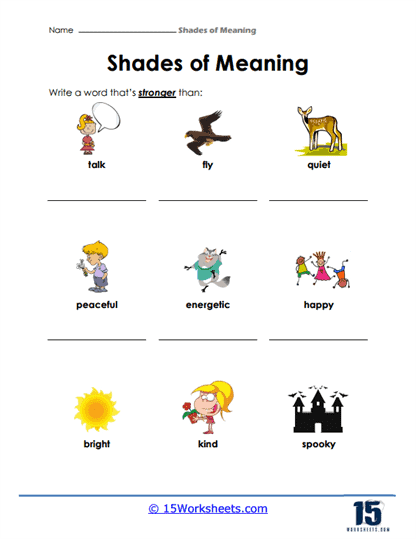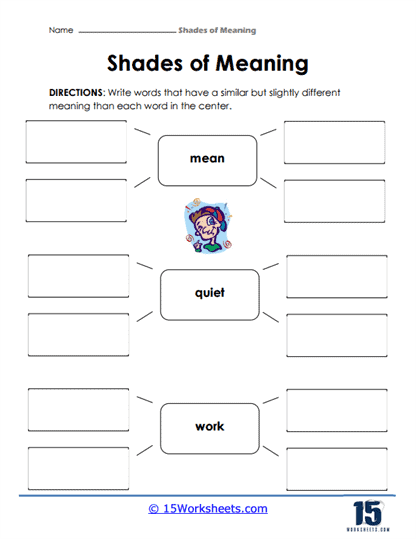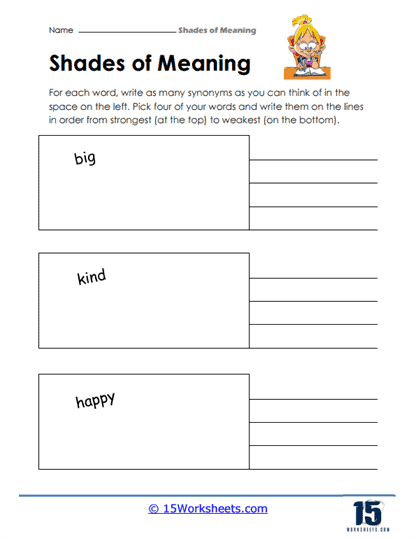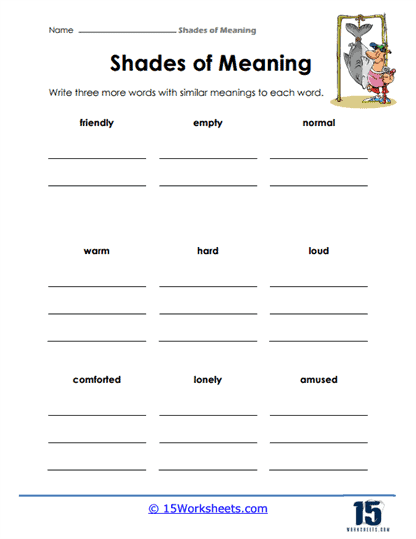Shades of Meaning Worksheets
All About These 15 Worksheets
These worksheets can help students comprehend the nuanced differences between similar words and understand the impact of these variations on text meaning. These worksheets serve as an essential part of language and reading comprehension instruction, enabling students to recognize, understand, and use vocabulary with precision and confidence.
The term “shades of meaning” refers to the slight differences between words or phrases that are similar, yet not exactly the same. It’s about understanding subtleties in language that can change the context, tone, and overall meaning of a sentence. These can include variations in intensity, emotion, or specific implications in different circumstances. For instance, the words “ask,” “request,” and “demand” may seem similar but carry differing levels of politeness and intensity.
By engaging with these worksheets, students deepen their vocabulary knowledge, enhance their expressive language abilities, and increase their reading comprehension skills. The ability to decipher subtle differences in word meanings can enhance a student’s ability to understand and interpret complex texts accurately. A nuanced vocabulary can also improve a student’s writing, providing a wider range of words to convey precise meanings and evoke specific emotions.
Here are some of the types of exercises you might expect to find on our shades of meaning worksheets:
Word Ladders or Continuums – Students are provided with a list of related words and asked to arrange them according to their intensity or degree. This exercise helps students discern fine distinctions between similar words.
Sentence Completion – In these exercises, students are given sentences with blank spaces and a list of words. They must select the most suitable word to complete each sentence, considering the subtle differences in each word’s meaning.
Matching Exercises – Students match words with their synonyms, antonyms, or definitions. This type of activity encourages students to reflect on the nuanced differences between words that appear to have the same or opposite meanings.
Story or Passage Analysis – Students read a short text and discuss or write about how the meaning would change if specific words were replaced with similar ones. This type of exercise requires higher-order thinking skills as students must understand the context and implied meaning within a text.
Creative Writing – Students write sentences or short paragraphs using a given set of words. They should strive to use each word in a context that highlights its unique shade of meaning.
Word Maps – Students create a visual representation of a word and its related terms. This can involve drawing connections between words, writing definitions, or using each word in a sentence.
To give a more concrete sense of how ‘shades of meaning’ works, consider these examples:
Shade of Meaning with “Happy” – In the sentence “I felt happy when I received a letter from my pen pal,” the word “happy” could be replaced with “thrilled” or “ecstatic.” Each replacement subtly changes the sentence’s meaning. “Thrilled” suggests a higher level of excitement than “happy,” while “ecstatic” implies an even stronger, almost overwhelming, level of joy.
Shade of Meaning with “Cold” – Consider the sentence, “The weather was cold today.” Replacing “cold” with “chilly” would suggest a less intense degree of coldness, implying that it’s slightly uncomfortable but bearable. On the other hand, using “freezing” instead would imply a harsh, uncomfortable degree of coldness.
Shade of Meaning with “Tidy” – In the sentence “He keeps his room tidy,” replacing “tidy” with “clean” would convey a similar but not identical meaning. “Clean” generally refers to the absence of dirt or mess, while “tidy” implies orderliness and organization. If “tidy” were replaced with “immaculate,” it would suggest a room maintained to an almost perfect standard, far beyond just being orderly.
The purpose of shades of meaning worksheets is to expand students’ vocabulary and enhance their ability to choose the most appropriate word for a given context. These worksheets often include activities such as word comparisons, synonyms and antonyms, word sorts, word analogies, and sentence completion exercises.



